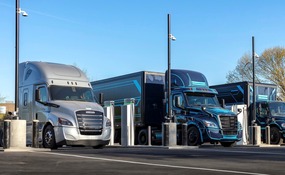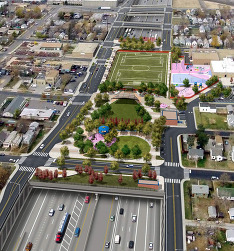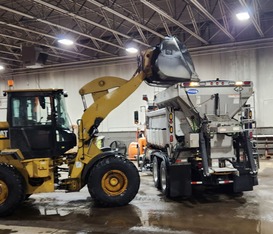|
Transportation Research Update
 Optimizing Charging Infrastructure for Electric Trucks

POLICY AND PLANNING — While personal electric vehicles (EVs), electric buses and other transit options are becoming more commonplace, medium- and heavy-duty electric trucks (e-trucks) are still largely in development. Medium- and heavy-duty trucks account for a substantial percentage of transportation greenhouse gas emissions. They also have greater power needs and different charging needs than personal EVs. Proactively planning for e-truck charging stations will support MnDOT in helping to achieve the state’s greenhouse gas reduction goals.
To understand e-truck charging infrastructure needs and barriers, researchers analyzed potential electricity needs in the context of the existing power grid. They worked with a variety of stakeholders to identify important considerations in locating charging stations, and then they employed a mathematical decision process tool to understand the most important criteria. A geospatial analysis and modeling of estimated truck trips revealed the optimal locations for e-truck charging stations. While the research only considered intrastate truck trips, the results will inform MnDOT’s further exploration into charging needs of other segments of the freight hauling sector.
This research was featured in the webinar “Electrification of the Freight System in Minnesota”, hosted by the University of Minnesota’s Center for Transportation Studies. A recording of the event is now available online.
|
Strengthening Communities with Innovative Right of Way Projects

MULTIMODAL — Urban highways were often built through communities, physically dividing them and creating social and economic hardships. MnDOT strives to ensure the transportation system furthers economic well-being and quality of life for all communities. The right of way (ROW) areas adjacent to highways can sometimes be used for non-transportation uses that benefit these communities. After learning about innovative ROW projects around the country, MnDOT is better prepared to help revitalize communities burdened for decades.
Researchers analyzed case studies of projects such as building land bridges over highways, developing highway underpasses and even removing a highway segment in ways that provide benefits to both the community and the traveling public. The examples highlight the primary importance of engaging and partnering with multisector partners, including community groups, public and private funders, and other agencies to develop facilities or spaces that the community wants and needs. The review also demonstrated best practices for facilitating and financing the ROW projects and promoting economic, social and environmental benefits. MnDOT can incorporate these principles in small or large projects requested by a community or as part of a larger agency planning effort.
Eight case studies in communities across the nation, improving land surrounding highways were featured in an online symposium, “Build Community Connections through Innovative Development of Rights of Way and Airspace,” a recording of the event is now available online.
|

MAINTENANCE OPERATIONS — Keeping roads clear during winter weather is a priority activity for MnDOT, and the agency routinely considers if new snow-fighting equipment will meet Minnesota’s needs. Recently several options caught MnDOT’s attention: three tools that could expand MnDOT’s plowing options—an underbody scraper, a true-float wing plow and a two-way reversible plow—and two slurry spreader systems intended for seasonal installation to provide a multilane spread of salt-and-water slurry treatment. New research put this equipment to the test in Minnesota winter conditions.
Over two winter seasons, researchers conducted a study of this equipment on the roads around Bemidji. The first winter focused on getting the equipment installed and working properly; interviews with operators, shop maintenance staff and management documented early successes and challenges. The second winter allowed a full season of data collection to assess how well the new spreaders could regain roads—or bring snow-covered roads back to bare lane condition—compared with traditional spreaders. Based on lessons learned and adjustments made over multiple seasons, MnDOT staff recommended the continued use and acquisition of all three types of plowing equipment. The benefits of the new slurry box equipment were less clear, but possible alternative configurations were proposed to address operational limitations and operator safety concerns.
|
Join Team MnDOT!

NOW HIRING - Do you have experience with project management or coordination? The Office of Research & Innovation looking for a Research Project Coordinator to work in St. Paul, supporting the Local Road Research Board and the agency’s Research Steering Committee. You will manage contracted research projects and participate in program outreach, collaboration and development. In addition, you will communicate and share transportation research with our partners including cities, counties and university researchers.
The state of Minnesota offers comprehensive benefits including pension, medical and dental coverage, paid vacation and sick leave. You also have the satisfaction of knowing that the work you’ll do will make a difference in the lives of Minnesotans. Join the talented, engaged and inclusive workforce dedicated to creating a better Minnesota.
If you’re interested, please apply on our MnDOT Careers page by October 3.
|
|
|
|
MnDOT invites and encourages participation by all people in their programs, services and activities.
If you need an ASL, a foreign language interpreter, or documents in an alternative format (such as braille, large print or in a different language) at no cost, please email your request to Janet Miller at ADArequest.dot@state.mn.us or call 651-366-4720. Relay service: 711.
If you need any other reasonable accommodation to participate (such as seating modification or auxiliary aids), please email your request to Accessibility.DOT@state.mn.us or call 1-833-400-8432. Relay service: 711.
|
|
|
|